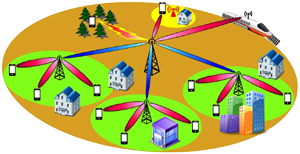5G rollout challenges and opportunities for frontier and emerging markets
DOI:
https://doi.org/10.3103/S0735272723040040Keywords:
5G, 5G Vision, mobile communications, cellular networks, LTE, wireless services, emerging markets, lower-middle-income economies, MNO, 5G roll-out, telecom policy, deployment strategy, regulation, eMBB, IoT, M2M, uRLLC, millimeter-wave, mmWave, small cells, Mid-Band Spectrum, vertical industries, ICT, digital economyAbstract
Cost efficiency is an essential metric in the design of major part of what is expected to be the 5G network. Some of the 5G solutions, mainly those involving mmWave technology and network densification, are extremely expensive. Much of what was said about 5G rollout strategies has been said with regard to the world’s major leaders in 5G technology and telecom infrastructure investment. However, a much more numerous group of countries often referred as emerging markets or middle-income economies has never hold a leadership in the development of cellular technologies. To date, few of them have fully leveraged the potential of 4G systems while many still have not ensured a return on investment in 3G. This gave rise to the views that these countries are not ready for 5G challenges. However, all of them are doomed to enter the era of another industrial revolution, where exactly 5G is to become the main driver. And yet, the use cases and the portfolio of services of the future networks will apparently depend on economic realities of the country where it will be deployed. There is a rather vague picture at the moment of how the 5G rollout may take place in this part of the world and that is the main reason for this study. In this paper, we outline the technical challenges and economic tensions associated with the developing of 5G physical infrastructure and address spectrum allocation issues with a particular focus on the needs of the future enhanced mobile broadband component. Then we discuss the role of government in establishing favorable regulatory framework, providing supportive policies and finding local drivers to facilitate 5G rollout and the challenges, confronting the operators paving their way to 5G.
References
- ITU, “Recommendation ITU-R P.2109-2 (08/2023) P Series: Radiowave propagation. Prediction of building entry loss,” 2023. uri: https://www.itu.int/rec/R-REC-P.2109-2-202308-I/en.
- S. Archer, “UBS: The super-fast next generation cell phone service only makes sense for the wealthy,” Markets Insider, 2017. http://uk.businessinsider.com/5g-cell-phone-service-only-makes-sense-for-the-wealthy-2017-7.
- W. Webb, “What is wrong with the 5G vision?,” Forum Europe EMS. https://eu-ems.com/event_images/Downloads/What is wrong with the 5G vision.pdf.
- “Setting the Scene for 5G: Opportunities & Challenges,” 2018. uri: https://www.itu.int/pub/D-PREF-BB.5G_01.
- D. Mavrakis, “Is C-Band the next frontier for 5G spectrum?,” 2017.
- E. Report, “The 5G business potential,” 2017. uri: https://www.economiadehoy.es/adjuntos/19430/Ericsson-5G-business-potential-report.pdf.
- M. Padgett, “Self-driving cars: who gets stuck with the highway bill?,” The Washington Post, 2017. https://www.washingtonpost.com/cars/self-driving-cars-who-gets-stuck-with-the-highway-bill/2017/05/16/2db93636-3a57-11e7-a59b-26e0451a96fd_story.html.
- G. Shenker, “First evolution, then revolution; 5G challenges for operators,” Radcom, ., 2018. https://radcom.com/first-evolution-then-revolution-5g-challenges-for-operators/.
- Q. W. Paper, “Setting off the 5G Advanced evolution,” 2021. uri: https://www.qualcomm.com/news/onq/2021/12/setting-5g-advanced-evolution.


